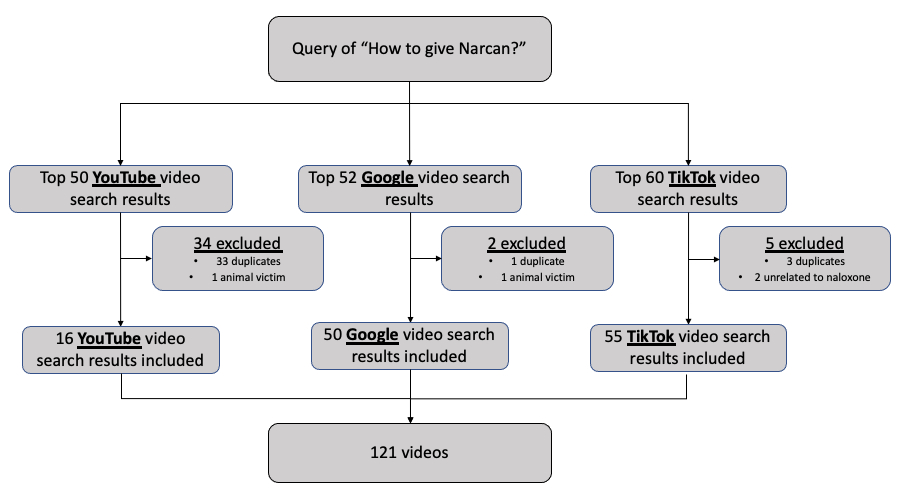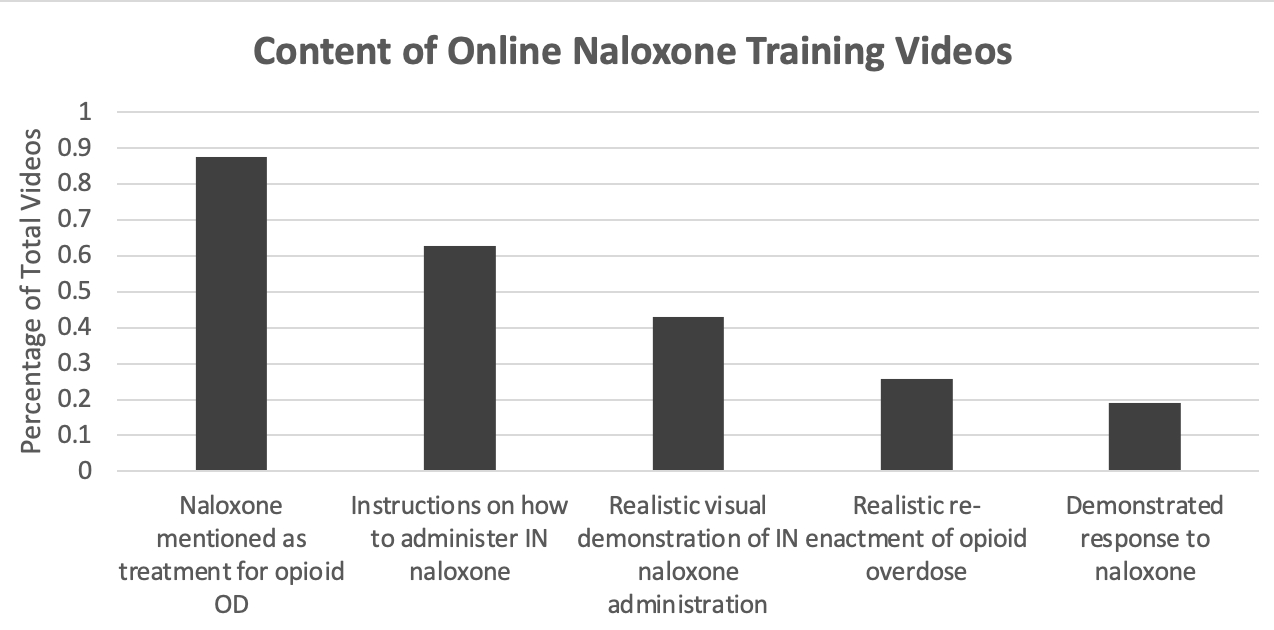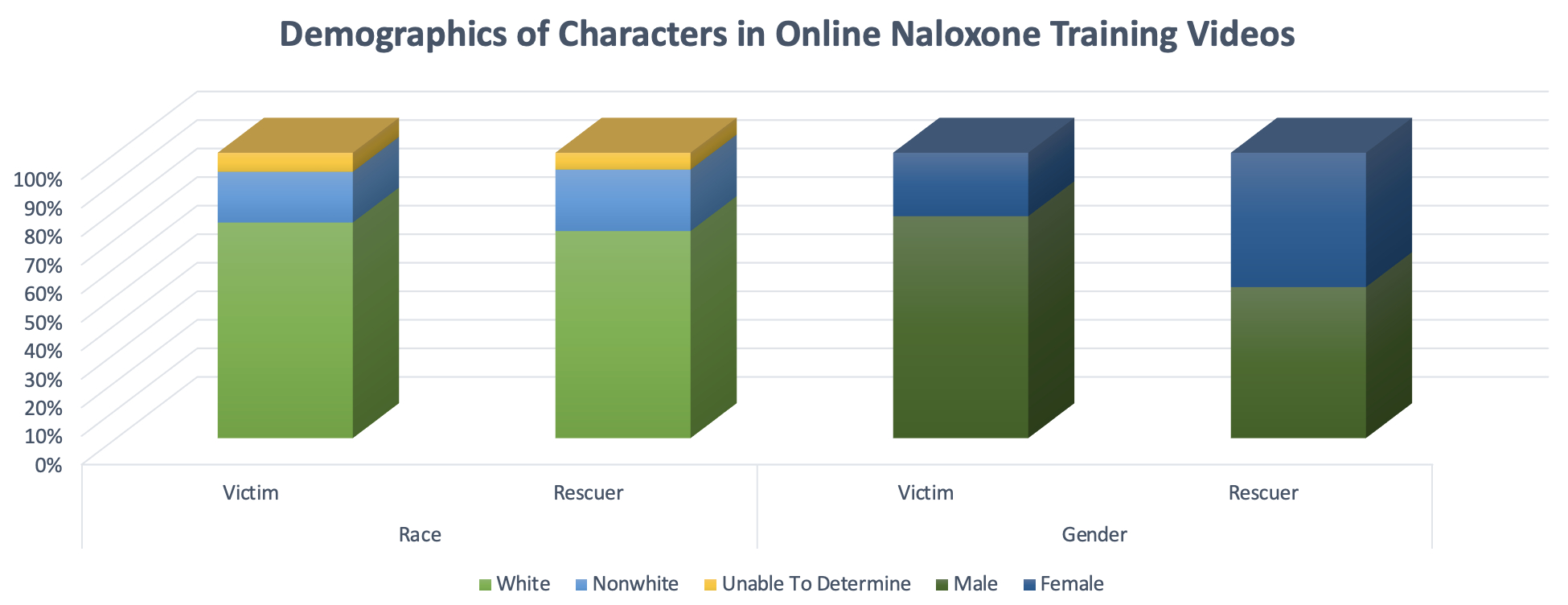Final ID: Su1107
Online educational film depiction of opioid overdose causing cardiac arrest
Abstract Body: Introduction
Opioid overdose (OD) is a growing cause of cardiac arrest in the US, spurred by the rise of illegally manufactured fentanyl and analogs. Naloxone is a reversal agent that can be administered by bystanders. Intra-nasal (IN) naloxone is now widely available in pharmacies across the US. Despite increasing access, minority populations remain disproportionately affected by drug overdose deaths. There are many free online opioid OD educational videos. Digital media can be a powerful tool for mass education, but the effectiveness is unknown.
Research Question and Aims
The goal of this study was to evaluate online opioid overdose videos for content and gender/racial representation.
Methods
We performed an online search with the query “how to give Narcan” (popular term for IN naloxone). Results were limited to the first 52 Google, 50 YouTube, and 60 TikTok videos. Exclusion criteria included: animal victim, duplicate, or no mention of naloxone. For each video, 2 reviewers evaluated content and identified the race and gender of featured characters. Disagreements were resolved through consensus. The race and gender of featured characters was compared using a two proportion z-test. Inter-rater reliability (IRR) for each data point was calculated using the arithmetic mean of Cohen's kappa.
Results
Of 121 videos, the majority (87.6%) mentioned naloxone as a treatment for opioid OD; 62.8% provided instruction on how to administer IN naloxone, and 4.1% featured a testimonial. Only 43.0% provided a realistic visual demonstration of IN naloxone administration; 25.6% showed a realistic re-enactment of opioid overdose, and even fewer (19.0%) showed the dramatic response to naloxone. IRR was high for all categories.
Videos predominantly featured white compared to non-white-appearing characters in both the victim (75.5 v. 17.8%, p< 0.00001) and rescuer roles (72.5 v 21.6%, p<0.00001). The rescuer gender was evenly distributed male v. female; however, the victim was more often male (77.8% v. 22.2%, p<0.00001).
Conclusion
Most online opioid OD videos provide instructions on how to use IN naloxone, but do not feature realistic depictions of cardiac arrest caused by opioid OD, naloxone treatment, or response. There is a significant lack of racial diversity in these videos. Digital materials are needed with improved diversity and which teach learners how to RECOGNIZE and respond to opioid OD.
Opioid overdose (OD) is a growing cause of cardiac arrest in the US, spurred by the rise of illegally manufactured fentanyl and analogs. Naloxone is a reversal agent that can be administered by bystanders. Intra-nasal (IN) naloxone is now widely available in pharmacies across the US. Despite increasing access, minority populations remain disproportionately affected by drug overdose deaths. There are many free online opioid OD educational videos. Digital media can be a powerful tool for mass education, but the effectiveness is unknown.
Research Question and Aims
The goal of this study was to evaluate online opioid overdose videos for content and gender/racial representation.
Methods
We performed an online search with the query “how to give Narcan” (popular term for IN naloxone). Results were limited to the first 52 Google, 50 YouTube, and 60 TikTok videos. Exclusion criteria included: animal victim, duplicate, or no mention of naloxone. For each video, 2 reviewers evaluated content and identified the race and gender of featured characters. Disagreements were resolved through consensus. The race and gender of featured characters was compared using a two proportion z-test. Inter-rater reliability (IRR) for each data point was calculated using the arithmetic mean of Cohen's kappa.
Results
Of 121 videos, the majority (87.6%) mentioned naloxone as a treatment for opioid OD; 62.8% provided instruction on how to administer IN naloxone, and 4.1% featured a testimonial. Only 43.0% provided a realistic visual demonstration of IN naloxone administration; 25.6% showed a realistic re-enactment of opioid overdose, and even fewer (19.0%) showed the dramatic response to naloxone. IRR was high for all categories.
Videos predominantly featured white compared to non-white-appearing characters in both the victim (75.5 v. 17.8%, p< 0.00001) and rescuer roles (72.5 v 21.6%, p<0.00001). The rescuer gender was evenly distributed male v. female; however, the victim was more often male (77.8% v. 22.2%, p<0.00001).
Conclusion
Most online opioid OD videos provide instructions on how to use IN naloxone, but do not feature realistic depictions of cardiac arrest caused by opioid OD, naloxone treatment, or response. There is a significant lack of racial diversity in these videos. Digital materials are needed with improved diversity and which teach learners how to RECOGNIZE and respond to opioid OD.
More abstracts on this topic:
A Porcine Model of Cardiac Arrest Without Pre-Arrest Fluid Loading, Sternal Molding, or Epinephrine
Paradis Aidan, Paradis Norman, Gaddy David, Moodie Karen, Mader Timothy, Dufresne Alexandre, Couturier Christine, Dufresne Simon, Davis Daniel, Sims Christopher
Alcohol Use and Hypertension in the Eastern CaribbeanFraser Katharine, Acosta Lisbette, Galusha Deron, Maharaj Rohan, Oladele Carol



